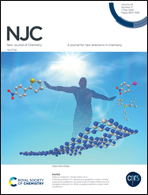Enzymatic deposition of PPy onto cPEG-grafted silk fibroin membrane to achieve conductivity†
Abstract
Silk fibroins (SFs) have many attractive properties; however, the practical applications of pure fibroin materials are severely restricted by their low elasticity. To improve flexibility of regenerated SF membranes, carboxyl-terminated polyethylene glycol (cPEG) was introduced into fibroin chains using 1-ethyl-3-(3-dimethylaminopropyl)carbodiimide hydrochloride (EDC) and N-hydroxysuccinimide (NHS). Subsequently, laccase-mediated graft polymerization of polypyrrole (PPy) onto the SF-g-cPEG membrane was performed to achieve electrical conductivity. The results implied that cPEG was successfully grafted onto the SF chains; the elongation at break of the SF-g-cPEG membrane increased by three times compared to that of the untreated one. Meanwhile, the introduced cPEG promoted the binding of pyrrole radical cations onto fibroin membrane, resulting in an efficient deposition of a PPy conductive layer during the laccase treatment. Conductivity of the membrane of SF-g-cPEG/PPy meets the standard of conductive materials even after 48 cycles of bending testing. In addition, the composite membrane has acceptable in vitro biocompatibility. The present work provides a novel alternative for fabrication of flexible and conductive SF biomaterials, which would expand the applications of fibroin materials in wearable electronics.



 Please wait while we load your content...
Please wait while we load your content...